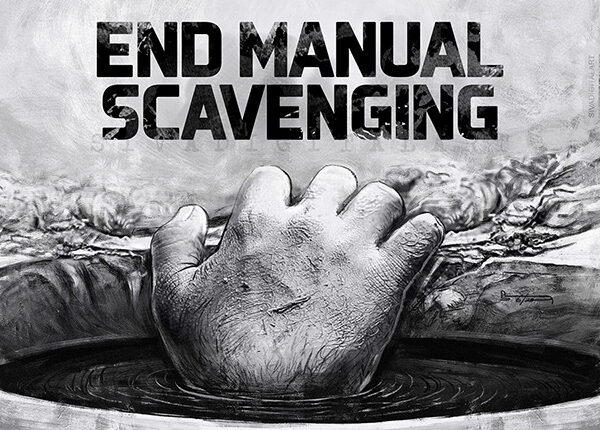– Mohd Naushad Khan
The continued existence of manual scavenging in India, particularly in an era marked by technological advancements like Artificial Intelligence, tarnishes the country’s growth story and violates the fundamental right to life with dignity. Despite being legally banned through various legislative measures, this practice persists, with recent deaths in Delhi and Uttar Pradesh highlighting its grim reality.
Manual scavenging, deeply rooted in India’s caste system, historically assigned this degrading task to Dalits, specifically sub-castes such as Valmikis and Helas, considered untouchables. This rigid societal hierarchy perpetuated cycles of poverty and discrimination, confining these groups to the margins.
Government data reveals that 339 people have died while cleaning sewers and septic tanks in India over the past five years. Ramdas Athawale, Minister of State for Social Justice and Empowerment, reported nine such deaths in 2023, 66 in 2022, 58 in 2021, 22 in 2020, 117 in 2019, and 67 in 2018.
The Prohibition of Employment as Manual Scavengers and their Rehabilitation (PEMSR) Act, 2013, explicitly bans manual scavenging. However, enforcement is lacking. The Supreme Court of India abolished the practice in 2013 and directed states to ensure compliance. In Delhi, the government acquired 200 machines to mechanize sewage cleaning, yet over 50 manual scavengers have died in the past five years alone.
Official data indicates one manual scavenger death every five days since January 2017. The Safai Karamchari Andolan, an organization advocating for the rights of manual scavengers, reported 429 such deaths in Delhi from 2016 to 2018.
In 2013, the government identified 12,742 manual scavengers across 13 states, with 82% in Uttar Pradesh. The 2011 census showed 740,078 households still relying on manual scavenging. By 2021, surveys identified 58,098 manual scavengers, yet the government claimed no ongoing practice of manual scavenging. Contrarily, the Safai Karamchari Andolan asserts that over 770,000 individuals are still engaged in this work.
The MS Act, 2013, mandates severe penalties for employing manual scavengers, yet weak enforcement persists. The Employment of Manual Scavengers and Construction of Dry Latrines (Prohibition) Act, 1993, and the PEMSR Act, 2013, aimed to abolish manual scavenging and rehabilitate those affected. However, lack of awareness, education, and alternative employment opportunities force many into this hazardous occupation.
Local governments often fail to enforce laws or provide adequate support for transitioning out of manual scavenging. Poor sanitation infrastructure, especially in rural areas, necessitates manual intervention. Mechanization of sewage cleaning remains insufficiently widespread.
Manual scavenging severely impacts health, exposing workers to harmful gases, infections, and chronic illnesses. Social ostracism and discrimination add to their psychological burden.
Despite these challenges, there are notable efforts towards eradicating manual scavenging. Bezwada Wilson of the Safai Karamchari Andolan received the Ramon Magsaysay Award in 2016 for his advocacy. Ashif Shaikh of Jan Sahas Social Development Society has rehabilitated over 40,000 individuals. Public figures like Amitabh Bachchan and grassroots movements like Garima Abhiyan have also contributed significantly.
Technological innovations offer hope. Engineers in Kerala developed the Bandicoot robot, which efficiently cleans sewers. IIT Madras researchers have also created robots for septic tank cleaning.
Stronger enforcement mechanisms, comprehensive rehabilitation programs, and increased awareness are crucial. Community engagement, educational initiatives, and investment in sanitation infrastructure can drive change. Collaboration between government and private sectors can promote technological solutions, while grassroots organizations play a vital role in bridging policy and practice gaps.
Eradicating manual scavenging is not just a legal obligation but a moral imperative. It requires a collective effort to dismantle sustaining structures. Through education, enforcement, innovation, and community support, India can ensure a dignified life for all its citizens.
This practice is a stark reminder of societal inequalities. While legal measures and technology pave the way for its eradication, addressing underlying social and economic factors is essential. By fostering a culture of dignity, equality, and respect, manual scavenging can become a relic of the past, providing opportunities for all to earn a living with pride.




